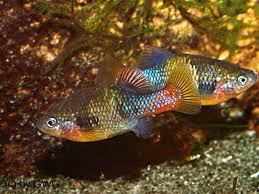Current Fish List: April 15, 2014, (78) Tanks (1094.5 Gallons of Fish Tanks). I have included the common names of most fish in this posting, for those that don’t like using the scientific names.
Livebearers:
Goodeids:
- Gold-breast Splitfin, Ilyodon furcidens – CN 2013
- Balsas Splitfin – Lennoni, Ilyodon lennoni – Meyer & Förster, 1983, TBA Auction (Nov, 2012)
- Butterfly Goodeid, Ameca splendens – CN 2013
- Jeweled Splitfin, Xenotoca variata – Gone “2014” (Will repurchase for breeding purposes shortly)
- Redtail Splitfin, Xenotoca eiseni – BS 2013, SKS Auction, BD 2014
- Tequila, Splitfin, Zoogonecticus tequila – CN 2013
- Black-fin Goodeid or Green Goodeid, Goodea atripinnis – Imperial Tropical’s 2013
- Black Prince Goodeid, Charcodon audax – Rkrzynowek, AQBD, Port Chester NY
- Splotched Skiffia, Skiffia multipunctata, John Noerpel, York Springs PA, Jan 2014
- Golden Skiffia, Skiffia francesae sayula – jrpatter#79 – TBA Auction (April, 14, 2014)
- Zirahuén Allotoca, Allotoca meeki, Opopeo, GWG (Goodied working group)
- Limones splitfin, Ilyodon xantusi, (Hubbs and Turner, 1939), louiestank.com AQBD 2014, Collection Location being researched by seller.
Mollies:
- Gilli Molly, Poecilia gilli, La Marguerita, Panama, Goliad Farms, Inc.
- Mexican Molly, Poecilia mexicana, Campeche, Goliad Farms, Inc.
- Salvatory Molly, Poecilia salvitoris, Honduras, Goliad Farms, Inc.
- Wild Green Sailfin Molly, Poecilia petenensis, Goliad Farms, Inc.
- Poecilia butleri, Swampriveraquatics, AQBD, Miami FL 33135
- Poecilia latipinna, Wild Caught, Lakeland FL 2013
- Wild Peurto Rican Guppys, Poecilia reticulata, Teddy123, Mayaguez Puerto Rico 00680-1504 Puerto Rico
- Domestic Guppy’s, Poecilia reticulata,
- Mosco Blacks, Variety, Mason, TBA, March 2014
- Half Blacks, Variety,
- Half Red albino’s, Variety
- Poecilia veliferia,
- Poecilia wingei ,
- Domestic: Poecilia sphenops & Poecilia latipinna (many colors).
- Silver Sailfin Molly, TBA Auction 2012
- Black Molly, WM 2012
- Black Molly Lyre-tail, PETCO 2014
- Marble Molly (Melanistic) WM 2012
- Gold Wag Sailfin Molly, MW 2013
Other Livebearers:
- Giardinius metalicus, SKS Meeting 2013
- Giardinius denticulatus, TBA Auction 2012
- Giardinius microdactylus, Mr Southwest, AQBD 2014
- Giardinius falcatus, ?
Limias:
- Limia Tiger sp., Mr Southwest, AQBD 2014
Phallichthys
- Merry widow livebearer, Phallichthys amates () Mr Southwest, AQBD 2014 (DIED 2104) Not Sure I will replace!
Cichlids:
- Convicts Black, Amatitlania nigrofasciata, 5 D’s Tropical’s; 2012
- Pink Convicts, Amatitlania nigrofasciata, 5 D’s Tropical’s; 2012
- Calico cichlids, Amatitlania nigrofasciata, ML, TBA Auction (March 2014)
- Kribs, Both red and albino, Pelvicachromis pulcher, 5 D’s Tropical’s; 2014
- Kribs, juveniles, Pelvicachromis pulcher – LAZ#97- TBA Auction (April, 14, 2014)
- Apistogramma macmasteri (A120 – A121) jrpatter, TBA Auction (April, 14, 2014)
For Catfish
- Brown Bristlenose, Ancistrus cirrhosus, 5 D’s Tropical’s; 2012
- Albino Bristlenose, 5 D’s Tropical’s; 2012
- Long-fin Bristlenose, Chris Baez, 2013
- Blue Eyed Bristlenose, SKS Meeting, July 2-13 Arizona Breeder
- Breen/Bronze, Cordoras aeneus, 5 D’s Tropical’s; 2012
- Albino Cory, Cordoras aeneus, 5 D’s Tropical’s; 2012
- Peppered Cory, Corydoras paleatus,
- Corydoras trilineatus,
- Corydoras melini,
- Panda Cory, Corydoras panda (short & long-tail),
- Corydoras zygatus,
- Corydoras agassizii ,
- Corydoras blochi,
- Corydoras sterbai,
- Corydoras habrosus
- Aspidoras albator
- Aspidoras spilotus.
Killifish:
- Heterandria formosa, Least Kiliifish, Wild Caught, Zephyrhills, FL 2012-2014
- Jordanella floridae, Florida Flagfish, Wild Caught, Zephyrhills, FL 2014
- Fundulus chrysotus, Golden Top-minnow, Wild Caught, Zephyrhills, FL 2014
- Lucania goodei, Blue-fin Killifish, Wild Caught, Lakeland, FL, 2013
(78) Tanks (1094.5 Gallons of Fish Tanks)
- (4) 55 gallon (220 Gallons)
- (1) 30 Gallon Tanks (30 Gallons)
- (9) 20 gallon long (180 Gallons)
- (19) 5.5 gallon (104.5 Gallons)
- (46) 10 gallon (460 Gallons)
- (Space for (10) more (10) gallon tanks) (100 Gallons)










